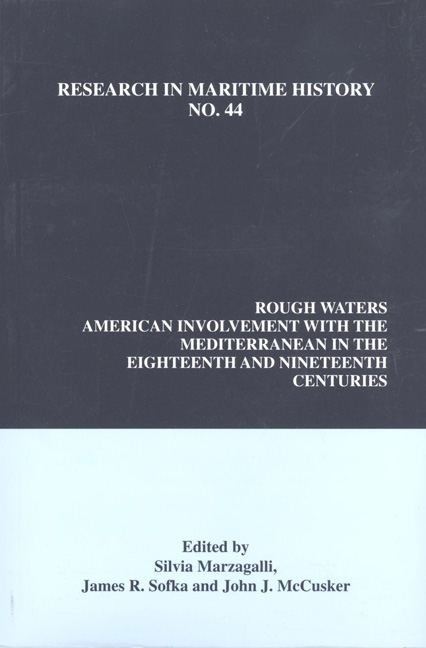Book contents
- Frontmatter
- Contents
- About the Editors
- Contributors' Notes
- “Rough Waters: American Involvement in the Mediterranean in the Eighteenth and Nineteenth Centuries: An Introduction”
- “Worth a War? The Importance of the Trade between British America and the Mediterranean”
- “Relations between North America and the Italian Peninsula, 1763-1799: Tuscany, Genoa and Naples”
- “American Shipping into the Mediterranean during the French Wars: A First Approach”
- “Notes toward a Franco-American Mediterranean 'From Below'”
- “Consuls and Consiglieri: United States Relations with the Italian States, 1790-1815”
- “Old and New Republics: Diplomatic Relations between the Republic of Genoa and the United States of America”
- ‘“From the Halls of Montesuma, to the Shores of Tripoli:’ Antoine Zuchet and the First Barbary War, 1801-1805”
- “Minorca: The First United States Naval Base in the Mediterranean and the American Consulate at Port Mahon”
- “‘The Jeffersonian Idea of National Security’ Revisited”
- “The Reluctant Warrior: Thomas Jefferson and the Tripolitan War, 1801-1805”
- “Slavery as Social Mobility? Western Slaves in Late Eighteenth Century Algiers”
- “Americans in the Mediterranean in the Late Eighteenth and Early Nineteenth Centuries: Concluding Remarks”
“Relations between North America and the Italian Peninsula, 1763-1799: Tuscany, Genoa and Naples”
- Frontmatter
- Contents
- About the Editors
- Contributors' Notes
- “Rough Waters: American Involvement in the Mediterranean in the Eighteenth and Nineteenth Centuries: An Introduction”
- “Worth a War? The Importance of the Trade between British America and the Mediterranean”
- “Relations between North America and the Italian Peninsula, 1763-1799: Tuscany, Genoa and Naples”
- “American Shipping into the Mediterranean during the French Wars: A First Approach”
- “Notes toward a Franco-American Mediterranean 'From Below'”
- “Consuls and Consiglieri: United States Relations with the Italian States, 1790-1815”
- “Old and New Republics: Diplomatic Relations between the Republic of Genoa and the United States of America”
- ‘“From the Halls of Montesuma, to the Shores of Tripoli:’ Antoine Zuchet and the First Barbary War, 1801-1805”
- “Minorca: The First United States Naval Base in the Mediterranean and the American Consulate at Port Mahon”
- “‘The Jeffersonian Idea of National Security’ Revisited”
- “The Reluctant Warrior: Thomas Jefferson and the Tripolitan War, 1801-1805”
- “Slavery as Social Mobility? Western Slaves in Late Eighteenth Century Algiers”
- “Americans in the Mediterranean in the Late Eighteenth and Early Nineteenth Centuries: Concluding Remarks”
Summary
American and Italian historians have for the most part based their understanding of late eighteenth-century relations between North America (mostly the newly independent United States) and the states of the Italian peninsula on the printed accounts and correspondence of a few enterprising travellers, reciprocal constitutional influences or diplomatic endeavours. While there is little new that can be said from these perspectives, in recent years the Italian historian Andrea Addobbati has revolutionized our understanding of eighteenth-century relations between Tuscany and the United States by examining business exchanges. For his part, the French historian Pierre Gervais has challenged the commonplace notion of a homogeneous Atlantic world, emphasizing instead the significance the “thick web of relationships” that extended many existing European networks to North America based on family connections and commercial chains of trust. The following review of the early relations between North America and the Italian peninsula describes a steady exchange of goods and people between the Grand Duchy of Tuscany, the Republic of Genoa and the Kingdom of Naples, on the one hand, and British North America and the United States on the other. By piecing together what was previously unknown or unconnected, it indirectly confirms Gervais’ interpretation.
It is a truism that the British continental colonies, Newfoundland and New France on the western shores of the Atlantic and the states of the Italian peninsula on the other side of the sea showed little interest in each other until well after the end of the Seven Years’ War (1763) and perhaps not until after the end of the American War of Independence in 1783. Still, given the available evidence and the fact that until 1783 almost everything “American” went under the British flag, there seems to have been more going on than was previously believed. Aside from Philadelphia, the area of West Florida, then under British jurisdiction, seemed to have the most interest in Italian products. A 1766 shopping list of the Governor of West Florida, George Johnstone (1730- 1780) included “Genoa Coarse Paper. Spanish Cards made there. Women's Stockings made of coarse silk…Velvets Flowered & Plain. Silks of different kinds. All kind of Glass Ware.” In 1770-1771 the Gazzetta Toscana reported that eighty, ninety and 100 mules were sent from Italy to West Florida on three different British ships.
- Type
- Chapter
- Information
- Rough WatersAmerican Involvement with the Mediterranean in the Eighteenth and Nineteenth Centuries, pp. 25 - 42Publisher: Liverpool University PressPrint publication year: 2010

